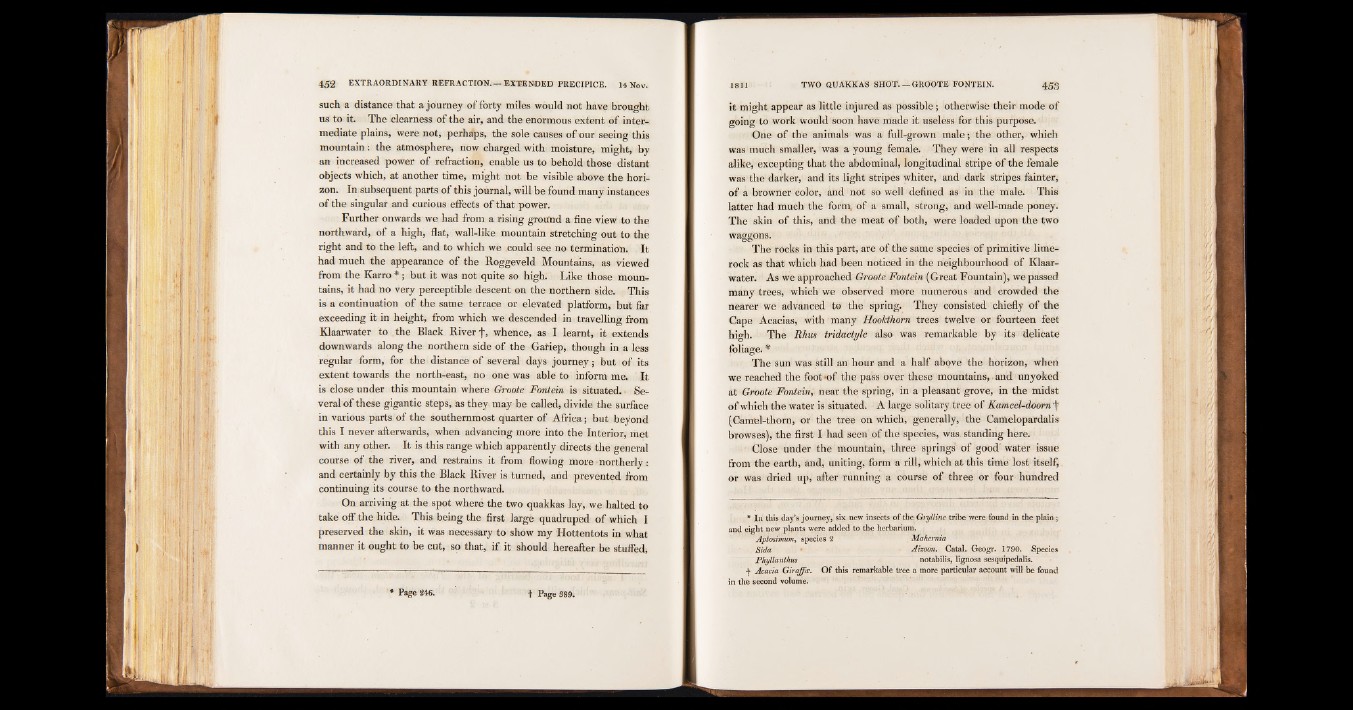
such a distance that a journey of forty miles would not have brought
us to it. The clearness of the air, and the enormous extent of intermediate
plains, were not, perhaps, the sole causes of our seeing this
mountain: the atmosphere, now charged with moisture, might, by
an increased power of refraction, enable us to behold those distant
objects which, at another time, might not be visible above the horizon.
In subsequent parts of this journal, will be found many instances
of the singular and curious effects of that power.
Further onwards we had from a rising ground a fine view to the
northward, of a high, flat, wall-like mountain stretching out to the
right and to the left, and to which we could see no termination. It
had much the appearance of the Roggeveld Mountains, as viewed
from the Karro *; but it was not quite so high. Like those mountains,
it had no very perceptible descent on the northern side. This
is a continuation of the same terrace or elevated platform, but far
exceeding it in height, from which we descended in travelling from
Klaarwater to the Black River f, whence, as I learnt, it extends
downwards along the northern side of the Gafiep, though in a less
regular form, for the distance of several days journey; but of its
extent towards the north-east, no one was able to inform me. It
is close under this mountain where Groote Fontein is situated. • Several
of these gigantic steps, as they may be called, divide the surface
in various parts of the southernmost quarter of Africa; but beyond
this I never afterwards, when advancing more into the Interior, met
with any other. It is this range which apparently directs the general
course of the river, and restrains it from flowing more northerly;
and certainly by this the Black River is turned, and prevented from
continuing its course to the northward.
On arriving at the spot where the two quakkas lay, we halted to
take off the hide. This being the first large quadruped of which I
preserved the skin, it was necessary to show my Hottentots in what
manner it ought to be cut, so that, if it should hereafter be stuffed,
* Page 246. t Page 389.
it might appear as little injured as possible; otherwise their mode of
going to work would soon have made it useless for this purpose.
One of the animals was a full-grown male; the other, which
was much smaller, was a young female. They were in all respects
alike, excepting that the abdominal, longitudinal stripe of the female
was the darker, and its light stripes whiter, and dark stripes fainter,
of a browner color, and not so well defined as in the male. This
latter had much the form, of a small, strong, and well-made poney.
The skin of this, and the meat of both, were loaded upon the two
waggons.
The rocks in this part, are of the same species of primitive lime-
rock as that which had been noticed in the neighbourhood of Klaarwater.
As we approached Groote Fontein (Great Fountain), we passed
many trees, which we observed more numerous and crowded the
nearer we advanced to the spring. They consisted chiefly of the
Cape Acacias, with many Hookthom trees twelve or fourteen feet
high. The Rhus tridactyle also was remarkable by its delicate
foliage. *
The sun was still an hour and a half above the horizon, when
we reached the foot-of the pass over these mountains, and unyoked
at Groote Fontein, near the spring, in a pleasant grove, in the midst
of which the water is situated. A large solitary tree of Kameel-doom f
(Camel-tliorn, or the tree on which, generally, the Camelopardalis
browses), the first I had seen of the species, was standing here.
Close under the mountain, three springs of good' water issue
from the earth, and, uniting, form a rill, which at this time lost itself,
or was dried up, after running a course of three or four hundred
* In this day’s journey, six new insects of the Grylline tribe were found in the plain;
and eight new plants were added to the herbarium.
Aptosimum, species 2 . Mahemia
Sida • Aizoon. Catal. Geogr. 1790. Species
Phyllanthns notabilis, lignosa sesquipedalis.
+ Acacia Giraffcc. Of this remarkable tree a more particular account will be found
in the second volume.